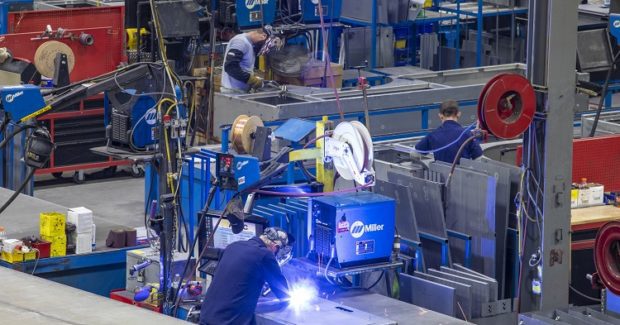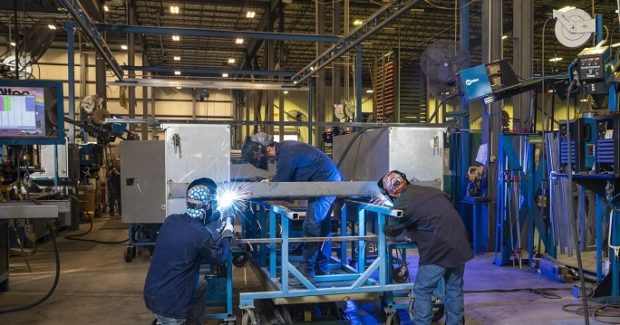Manufacturing vs. Fabrication: How to Make the Distinction
Is your operation highly repeatable or do you require more equipment and personnel flexibility for a wider range of work? Knowing the difference is important in selecting the right equipment and process optimization needed to maximize productivity, save time and money.
Posted: April 13, 2019
In welding, the line between manufacturing and fabrication can be blurry. A manufacturing operation typically has different needs and priorities than a fabrication shop – and it comes down to more than just size and output. So how can you tell if your operation is manufacturing or fabrication? When considering this issue, it’s important to look beyond the total number of arcs and think instead about factors such as the type of work being completed and how that work gets done. Knowing where you most closely align can help in making better decisions about equipment selection and process optimization needed to maximize productivity, save time and money. Here are four questions that can help you determine if manufacturing or fabrication fits your operation best.
QUESTION 1: IS THE WORK HIGHLY REPEATABLE?
A critical difference between fabrication and manufacturing is the level of repeatability in the welding operation. Manufacturing is often highly repeatable, while fabrication is typically lower volume or one-off projects. That’s not to say manufacturers don’t have some variation in parts; they typically have a lower mix and higher volume product composition. Though their end products may vary, their welding process doesn’t change much. Most often, a manufacturing welding operation follows a standard print and is often characterized by individual unit production. Parts are brought to the weld cell prepared and ready to weld, and the parts being produced across different assembly lines often come together in a finished product. Manufacturers typically look for large-scale contracts with part volume rather than one-off projects, and welders in a manufacturing operation tend to have more specialized roles.
In many types of fabrication, welders often need the versatility to do it all, from setup and bending to welding and grinding. That’s because parts in a fab shop may come to the weld cell not yet ready to be welded. They may receive a pallet bin with parts, a blueprint, call outs and weld procedures, and the welder might have to fit and fab on the go. This often requires more in-cell gouging, cutting, grinding, fitting, bending and tacking. Of course, some companies produce parts across the spectrum and don’t easily fit into either the manufacturing or fabrication bucket. A common term for these types of shops is “manu-fab.” They typically work on larger, more custom projects that require various skills to complete. They never face the same challenges day to day – and selecting the proper welding equipment and solutions can make facing these challenges easier.
QUESTION 2: IS THROUGHPUT THE MOST IMPORTANT METRIC?
Productivity is important in every company, but throughput is typically the most critical key performance indicator for manufacturers. Labor is the largest expense, so it’s all about minimizing downtime, maximizing labor time and getting as many parts out the door as possible. This makes high quality and consistency extremely important. Time and money spent on rework is a major blow to throughput in a production facility. Reducing time spent on rework and post-weld cleanup means more value-added time for a welder under the hood. Pulsed welding processes are a solution that can help reduce rework and minimize the effect of operator variation in producing high-quality welds.
While the quality of the first weld pass is still important in fabrication, these shops are often more nimble to adjust as needed. Throughput is important, but often not critical, because a fab shop doesn’t have parts backing up on the production line for every minute spent on a rework project. Welding intelligence systems can help companies of all types and sizes measure welding activities and drill down into important data, offering real-time insight into metrics such as arc-on time, weld defect rates and missed welds.
QUESTION 3: IS FLEXIBILITY CRITICAL?
Because on-the-go flexibility is often key in fabrication shops, multi-process versatility is an important feature when choosing welding power sources. Fab shops want to be able to handle any job that comes through the door, whether the material for the project is carbon steel, cast iron, stainless or Inconel. Welding equipment that doesn’t allow the shop to complete a wide variety of work is a limitation, while equipment that offers ultimate flexibility is an asset. The types of material to be welded most often is one factor that helps a company determine the machines they need on the shop floor. The versatility of a multi-process machine helps shops optimize efficiency in a wide range of fabrication jobs. In highly-repeatable manufacturing operations, single-process machines that offer advanced MIG capabilities are often more common.
QUESTION 4: IS THERE FIXTURING?
Another key difference between manufacturing and fabrication is the fixturing for the weld. Manufacturing typically uses reusable fixturing for mostly in-position welds. In contrast, many fabrication applications don’t use fixturing: Welders often rely on clamps, chain hooks and other supports to hold parts in place for welding. Whether there is fixturing or not plays a role in which welding process is best suited for the application. A spray transfer or pulsed MIG offers significant benefits for productivity and efficiency in flat, horizontal welding with fixturing. A flux-cored process can deliver different benefits when welding out of position.
KNOW THE DIFFERENCE FOR AN OPTIMIZED PROCESS
Whether your operation is highly repeatable or one that requires more equipment and personnel flexibility for a wider range of work, you need the right welding equipment and systems to complete jobs efficiently and with high quality. Understanding the difference between fabrication and manufacturing – and the key factors that play a role – helps companies choose the right equipment and optimize their welding process for greater efficiency.
Danny Mortensen co-authored this article. He is the market segment manager for Construction | Fabrication at Miller Electric.


















